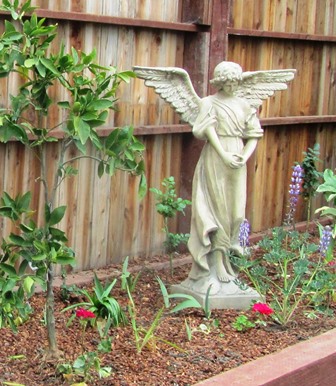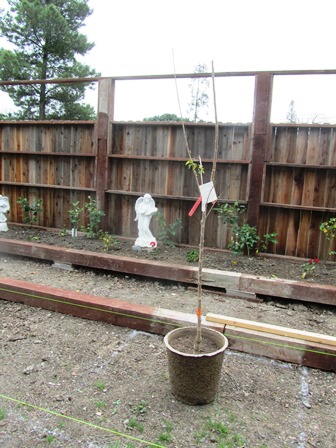The Start of Something Wonderful . . . Spring!
I jumped at the chance to visit my favorite nursery this past weekend after my husband suggested a drive to Livermore, California. Alden Lane Nursery occupies a beautiful setting amid ancient oaks and there is even a honeybee hive on the premises. Wisteria blooms in perfusion there this time of year.
We came away with some pepper plants, two smoke trees, and four cherry trees, including Bing and Black Tartarian, its pollinator.
We are going to plant the cherry trees at the front of our property and the smoke trees will go in that area as well. We’ve done very little landscaping on the front of our land, preferring to get the trees and gardens in at the back near our hives and chicken run.

The beds that run the length of the fencing at the front of the farmette feature statuary, citrus, and bedding plants
Everywhere you look on the farmette, there are projects to be done. We chip away at them when we can. My husband works days and I write my novels, so the work will undoubtedly be never-ending. But that’s okay. We aren’t in a hurry and it’s easier to just live by the cycles and seasons of nature.
When I think of how the peaches and apricots are forming and the bees are almost ready to swarm, I know spring is here. And it’s my favorite season, so I’ll go outside, ignore the projects, have a cup of tea, and enjoy the start of something wonderful!
Growing Peaches in Northern California
What could be more sublime that eating a juicy, ripe peach freshly plucked from the tree? If you have space in your Northern California backyard or garden, consider planting one or more peach trees.
In the Bay Area, peaches are fairly easy to grow. Depending on the cultivar, they are heavy bearing. We planted a classic gold Elberta and some early-bearing Desert Gold peaches two years ago. Already, both trees are loaded with peaches.
I ate a Desert Gold peach off the tree today. It was ripe on one side and still a little crunchy on the other. Another week, and they’ll all be ready for a cobbler. The Elberta peaches will not be ripe until late July or early August.
Peaches are best eaten fresh, in my opinion. But they also freeze well or you can make them into jam, preserve them with spices, or blend up a batch of chutney or baby food. Your best bet is to plant peach trees during bare root season because they are cheaper and more plentiful then. Right now (second week of May), nurseries have replanted their bare root trees into pots.
One of my favorite nurseries in the Bay Area is Alden Lane Nursery in Livermore, California. The nursery carries hundreds of fruit and nut trees and thousands of roses. The oak trees on the property are 300 years old and one has a community of honeybees dwelling in the tree. It’s a great time to visit the nursery. For a list of offers, see http://www.aldenlane.com/media/softprogram.pdf.
Peaches need a lot of sunshine, high nitrogen fertilizer, and water to perform optimally. They also suffer from peach leaf curl, a fungus that can be easily treated with a fixed-copper spray. Dormant oil will control scale if they get it. The trees will live for 15 to 20 years.
Prolific producers, peaches need fruit thinning early on to yield larger fruit and avoid branch breakage. See the University of California’s Master Gardener program tip sheet for more information at http://homeorchard.ucanr.edu/Fruits_&_Nuts/Peach/.
If you love peaches, it’s not too late to plant a tree in your backyard for a bountiful crop of late spring/summer fruit.
 Facebook
Facebook Goodreads
Goodreads LinkedIn
LinkedIn Meera Lester
Meera Lester Twitter
Twitter








